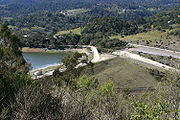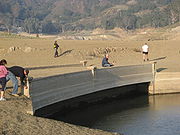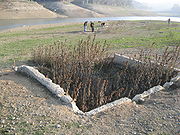
Lexington Reservoir
Encyclopedia



Los Gatos Creek (Santa Clara County, California)
The Los Gatos Creek runs 24 miles in California through Santa Clara Valley Water District's Guadalupe Watershed from the Santa Cruz Mountains northward through the Santa Clara Valley until its confluence with the Guadalupe River in downtown San Jose...
near Los Gatos, California
Los Gatos, California
The Town of Los Gatos is an incorporated town in Santa Clara County, California, United States. The population was 29,413 at the 2010 census. It is located in the San Francisco Bay Area at the southwest corner of San Jose in the foothills of the Santa Cruz Mountains...
. The James J. Lenihan Dam
James J. Lenihan Dam
James J. Lenihan Dam is an earthen structure across the Los Gatos Creek creating the Lexington Reservoir in the Santa Cruz Mountains of Santa Clara County, California south of Los Gatos. The name was changed from Lexington Dam in 1996 for the retirement of James J...
, a 195 ft (59.4 m) high, 1000 ft (304.8 m) thick earthen dam, forms the third-largest reservoir in Santa Clara County.
Background
The reservoir is in the foothills of the Santa Cruz MountainsSanta Cruz Mountains
The Santa Cruz Mountains, part of the Pacific Coast Ranges, are a mountain range in central California, United States. They form a ridge along the San Francisco Peninsula, south of San Francisco, separating the Pacific Ocean from San Francisco Bay and the Santa Clara Valley, and continuing south,...
, at an elevation of 645 feet (196.6 m).
State Route 17 runs alongside the dam's western edge and over part of the reservoir. Alma Bridge Road (Limekiln Canyon Road) runs around the eastern side, connecting with 17 at the north end and again at the south end via other surface streets.
The reservoir is contained in Lexington Reservoir County Park, which includes hiking trails in the hills with good views of the reservoir and of Silicon Valley
Silicon Valley
Silicon Valley is a term which refers to the southern part of the San Francisco Bay Area in Northern California in the United States. The region is home to many of the world's largest technology corporations...
. The Los Gatos Creek Trail
Los Gatos Creek Trail
The Los Gatos Creek Trail is a 9.7-mile pedestrian and bicycle trail that runs through western Santa Clara County in California, from Lexington Reservoir in Los Gatos, California through Campbell, California to Meridian Avenue in San Jose, California alongside Los Gatos Creek...
starts at the dam and continues downstream along the creek's canyon.
It is part of the Santa Clara Valley Water District
Santa Clara Valley Water District
The Santa Clara Valley Water District provides stream stewardship, wholesale water supply and flood protection for Santa Clara County, California, in the southern San Francisco Bay Area. The district encompasses all of the county’s and serves the area’s 15 cities, 1.7 million residents and more...
and provides water for Silicon Valley.
In October 2007, the Santa Clara Valley Water District began a construction project to replace the old 48 inches (1,219.2 mm) outlet pipe that runs through the base of the dam from the reservoir to Los Gatos Creek. The current outlet pipe will be replaced with a 54 inches (1,371.6 mm)-diameter pipe, new valves, outlet structures and a control building.
The repairs are being made to allow the reservoir to drain quickly enough during emergencies such as after a major earthquake that could cause cracks in the dam, or during a series of heavy winter storms that posed flooding risks to Los Gatos and Campbell.
History
In 1943, the Santa Clara Valley Water District identified that the well water in the Santa Clara ValleySanta Clara Valley
The Santa Clara Valley is a valley just south of the San Francisco Bay in Northern California in the United States. Much of Santa Clara County and its county seat, San José, are in the Santa Clara Valley. The valley was originally known as the Valley of Heart’s Delight for its high concentration...
was being diminished at a rapid rate and a dam was needed on the Los Gatos Creek, two miles (3 km) south of Los Gatos. One goal was to percolate the water into the ground and ultimately increase the amount of well water available. After rerouting State Route 17 near Windy Point which is a mile south of Los Gatos, dam construction began in the spring of 1952 and was completed in the fall of 1952.
The reservoir covered the towns of Lexington
Lexington, California
Lexington, California is a ghost town in Santa Clara County, now submerged by the Lexington Reservoir. It is located at latitude 34°11'47"N, longitude 121°59'14"W; decimal degrees: latitude 37.19639, longitude -121.98722. Originally located along Los Gatos Creek, the town was 550 feet above sea...
and Alma
Alma, California
Alma is a ghost town in Santa Clara County in California, United States. It lies beneath the waters of the Lexington Reservoir above Los Gatos. The location is latitude 37.18N and longitude 121.98W. It was 551 feet above sea level....
. Alma and Lexington reached their peak population in the mid-19th century, when about 200 people lived in each. Each of the towns had a post office, hotel, saloons, blacksmith
Blacksmith
A blacksmith is a person who creates objects from wrought iron or steel by forging the metal; that is, by using tools to hammer, bend, and cut...
shops, and half a dozen redwood sawmill
Sawmill
A sawmill is a facility where logs are cut into boards.-Sawmill process:A sawmill's basic operation is much like those of hundreds of years ago; a log enters on one end and dimensional lumber exits on the other end....
s. Lexington was the halfway stop for stagecoach
Stagecoach
A stagecoach is a type of covered wagon for passengers and goods, strongly sprung and drawn by four horses, usually four-in-hand. Widely used before the introduction of railway transport, it made regular trips between stages or stations, which were places of rest provided for stagecoach travelers...
es running between San Jose
San Jose, California
San Jose is the third-largest city in California, the tenth-largest in the U.S., and the county seat of Santa Clara County which is located at the southern end of San Francisco Bay...
and Santa Cruz
Santa Cruz, California
Santa Cruz is the county seat and largest city of Santa Cruz County, California in the US. As of the 2010 U.S. Census, Santa Cruz had a total population of 59,946...
. The town served as a place to switch from a team of four horses to six horses to get over the mountains. Lexington declined after 1880 when the narrow gauge railroad from Los Gatos to Santa Cruz bypassed it, while Alma declined when Highway 17 bypassed it in 1940. The railroad ceased operations in 1940. By 1950, only about 100 people lived in the two communities.
Lexington gained national attention in 1883, when a Los Gatos saloon keeper, Lloyd Majors, hired two thugs to rob an elderly Lexington man who kept $20,000 in gold in his cabin. They burned him with turpentine-soaked rags and beat him with pistols, killing him, and then fled with the gold. Their sensational trial in San Jose drew national attention similar to that accorded to the Lizzie Borden ax murders nine years later. Majors and one of the thugs were hanged. The other spent 15 years in prison.
Renovation Projects
In September 2007, the Santa Clara Valley Water District began its “Lenihan Dam Outlet Project” at Lexington Reservoir. This project replaced the old outlet pipe that releases water from Lexington Reservoir into some of the creeks and streams of Santa Clara Valley.In the past, the old pipe required frequent maintenance and repairs because it was aging and collapsed in several areas. The new outlet pipe, which runs through a new tunnel in Saint Joseph’s Hill (on the east side of the dam), also features new actuating valves and a new intake structure.
The project was completed in Fall of 2009, and “first release” celebration was held on Oct. 20, 2009. The Santa Clara Valley Water District features a Lexington Reservoir & Lenihan Dam Project project page on its website.
Lexington Reservoir County Park
Besides serving as a water supply for the area, the lake is used for rowing, paddling, and fishing. Santa Clara County manages the 960 acres (3.9 km²) Lexington Reservoir County Park. The park provides facilities for hiking and picnicking. The reservoir is stocked with black bassBlack bass
Micropterus , is a genus of freshwater fish in the sunfish family of order Perciformes. The type species is M. dolomieu, the smallmouth bass...
, trout
Trout
Trout is the name for a number of species of freshwater and saltwater fish belonging to the Salmoninae subfamily of the family Salmonidae. Salmon belong to the same family as trout. Most salmon species spend almost all their lives in salt water...
, bluegill
Bluegill
The Bluegill is a species of freshwater fish sometimes referred to as bream, brim, or copper nose. It is a member of the sunfish family Centrarchidae of the order Perciformes.-Range and distribution:...
, and crappie
Crappie
Crappie is a genus of freshwater fish in the sunfish family of order Perciformes. The type species is P. annularis, the white crappie...
. The park includes part of the San Andreas Fault
San Andreas Fault
The San Andreas Fault is a continental strike-slip fault that runs a length of roughly through California in the United States. The fault's motion is right-lateral strike-slip...
, which crosses Los Gatos Creek just south of the upstream end of the reservoir. The mountains feature redwood forests, chaparral
Chaparral
Chaparral is a shrubland or heathland plant community found primarily in the U.S. state of California and in the northern portion of the Baja California peninsula, Mexico...
, grasslands, hardwoods, and mixed conifer habitats.
When the level of Lexington Reservoir drops, it is possible to see portions of the old roads that were used in the construction of the reservoir and to the historic towns of Lexington and Alma that once existed in the valley before the reservoir was created. Some building foundations in the ghost town
Ghost town
A ghost town is an abandoned town or city. A town often becomes a ghost town because the economic activity that supported it has failed, or due to natural or human-caused disasters such as floods, government actions, uncontrolled lawlessness, war, or nuclear disasters...
s are also visible at times.
The photo at right shows a bridge across Black Creek, originally built in 1926. The bridge, along with a few house foundations from the towns of Lexington and Alma, have been exposed due to the drought conditions in 2008. These historical structures have been exposed only three or four times since the dam was constructed.

